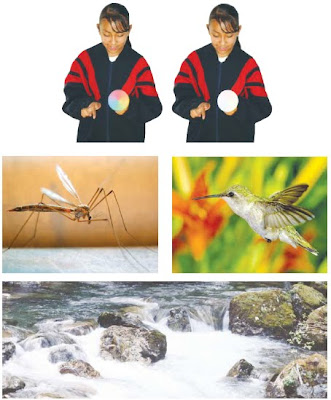HOW DO WE DESCRIBE OBJECT'S MOTION?
When is an object in motion?
*Deciding if an object is in motion is not as easy as you might think. For example, you are probably sitting in a chair as you read this ppt presentation. Are you moving?
*Parts of you are. Your eyes blink and your chest moves up and down. But you would probably say that you are not moving.
*An object is in motion if its position changes relative to another object.
*Because your position relative to your chair does not change, you could say that you are not in motion.
Physical problems
You are inside a bus in a bus terminal. There are several buses aligned with yours and the bus close to you moves backward very slowly.
Your seat partner says: “We have started to move”. However, for you, the bus is still at repose. Who is right? Explain your answer.
REFERENCE POINT
*To decide if you are moving, you use your chair as a reference point.
*A reference point is a place or object used for comparison to determine if something is in motion.
*An object is in motion if it changes position relative to a reference point.
*Objects that are fixed relative to Earth (such as a building, a tree, or a sign, the classroom corner, the center of a field) make good reference points.
Juan está jugando con su vecino a las canicas. La mamá de Juan observa al niño desde la puerta de su casa. En eso llega su papá manejando el vehículo, listo para estacionarlo en su casa y también observa al niño. ¿Quién cuenta con el mejor punto de referencia, el papá o la mamá?
What objects could serve as good reference points?
RELATIVE MOTION
*If you use a chair as your reference point as you sit and pay attention to the professor, you are not moving.
*If you choose another object as a reference point, you may be moving.
Earth moves around the sun at a speed of about 30 km/second. But because you are moving with Earth, you don not seem to be moving.
TRAJECTORY
*A trajectory is the path that a moving object follows through space as a function of time.
Another word similar to trajectory:
Way road path journey track course trail pathway avenue
Lane distance line itinerary
Describe the trajectory of each motion.
Rectilinear Circular Elliptical Parabolic Vibratory
Rotational Oscilatory Zig zag Random
¿Cómo es la trayectoria de?
Una gota de lluvia cayendo
Un joven manejando una bici
Una mariposa volando en el campo
La Tierra moviéndose alrededor del sol
La Tierra moviéndose alrededor de su eje
Los juegos mecánicos en una feria
Rueda de la fortuna
CONCEPTOS IMPORTANTES EN ESPAÑOL:
MOVIMIENTO: Es el cambio de posición de un cuerpo en el tiempo, tomando como referencia a otros cuerpos y siguiendo una trayectoria.
PUNTO DE REFERENCIA: Punto fijo de origen sobre el cual se basan los cambios de posición. Sirve para saber si algo se movió o no, para establecer respecto a qué se movió. Un buen ejemplo es un edificio o un árbol. Malos ejemplos son una mariposa y un automóvil.
TRAYECTORIA: Los cuerpos al moverse, lo hacen de muchas maneras. La trayectoria es la línea que describe la ruta seguida por un objeto en movimiento. En las ferias, el movimiento que efectúa la rueda de la fortuna es circular.
Las unidades de LONGITUD y TIEMPO utilizadas para medir los movimientos de los corredores en una competencia de atletismo son el METRO y el SEGUNDO.
Para DESCRIBIR CON PRESICIÓN algún fenómeno de la naturaleza, primero necesitamos observarlo y determinar sus magnitudes; es decir: medirlo.
LONGITUD: Distancia entre dos puntos
TIEMPO: Lapso que caracteriza la duración de un fenómeno.
METRO: Unidad fundamental para representar la distancia de acuerdo al Sistema Internacional
SEGUNDO: Unidad fundamental para medir el tiempo en el Sistema Internacional de Unidades.
II. Prepare yourself for the weekly quiz of trajectory and reference point.
III. Win 1 or 2 point for your quiz by preparing an exposition to explain what follows:









No hay comentarios:
Publicar un comentario